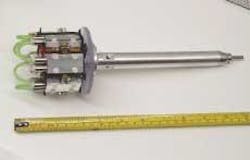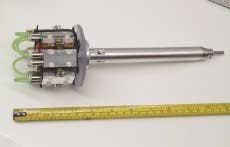In situ laser diode replaces spark plug
Internal-combustion engines have been undergoing improvement for more than a century. In the design of gasoline engines, fuel-ignition techniques remain an area of concentration for development engineers. Ignition is traditionally performed by electrical spark plugs that require high voltage and careful insulation. But spark plugs erode with use, and because they must remain at the edge of the combustion chamber, they offer only limited possibilities for optimizing engine efficiency and reducing noxious emissions.
In response, some laboratories have pursued the use of focused laser radiation for ignition.1 Radiation can be focused anywhere within the combustion chamber so that an optimal ignition point can be found for the unobstructed expansion of the flame front. Even multipoint ignition can be implemented. Laser ignition of very lean fuel mixtures has been demonstrated.2 In principle, laser ignition offers further parameters for optimization such as wavelength, pulse energy, and pulse shape and duration.
Now, researchers at Carinthian Tech Research (CTR; Villach, Austria) and AVL List (Graz, Austria) have developed a laser spark design that allows a traditional electrical spark plug in any engine to be replaced by a laser device so that ignition-improvement studies can be performed.3 Previously, laboratory engines had to be altered to allow the laser beam to be directed via mirrors or glass fibers into the combustion chamber. In the new design, the laser geometry fits to the engine, thus opening access to real applications (see figure).
A tube containing the optics is screwed directly into the cylinder head cover at the position of the usual spark plug. The radiation from twelve 808-nm-emitting laser diodes is combined to supply a 15-mJ pulse energy at 6-ns pulse duration, which suffices for most applications. The peak power density reaches approximately 200‑MW/cm2. Focusing the laser beam yields a power density of more than 1012‑W/cm2, sufficient for optical breakdown of air. Laser triggering is controlled by the usual spark-ignition signal; power is provided by the 12-V car battery.
“The greatest challenge was integrating a laser in a small space that can withstand the vibrations occurring in the engine and also remains stable at high temperatures of up to 300°C,” says Gerhard Kroupa, project manager at CTR. “Particulate and deposits on the optical window in the combustion chamber are burned off by the laser itself.” The initial operational tests were performed at AVL.
The device has several advantages. With laser ignition, no mechanical parts reach into the combustion chamber, favoring the unobstructed propagation of the flame front. Ignition can be started even inside a directly injected fuel spray, which is not possible with conventional spark electrodes. The engineer is free to position the igniting plasma plume within the cylinder. In addition to multipoint ignition, repeated ignition in case of misfire is possible.
Devices derived from the prototype may find application at first in large gasoline engines for stationary power plants. Because of their requirements for lean combustion, they not only compromise the lifetime of costly electrical ignition components, but also rely on cost-intensive exhaust-treatment devices. For such applications, the lifetime of laser-ignition equipment is estimated to be about ten times longer than that for electrical spark plugs. Because cleaner combustion systems are expected, the cost of the laser will be recovered in the reduction of conventional operating costs.
REFERENCES
1. M. McMillian et al., Gas Machinery Conf. 2003, DOE Research Review (Oct. 5-8, 2003).
2. H. Kopecek et al., Proc. Spring Tech. Conf. ASME Intl. Combustion Engine Division, ICES 2003, S. 614.
3. www.ctr.at.

